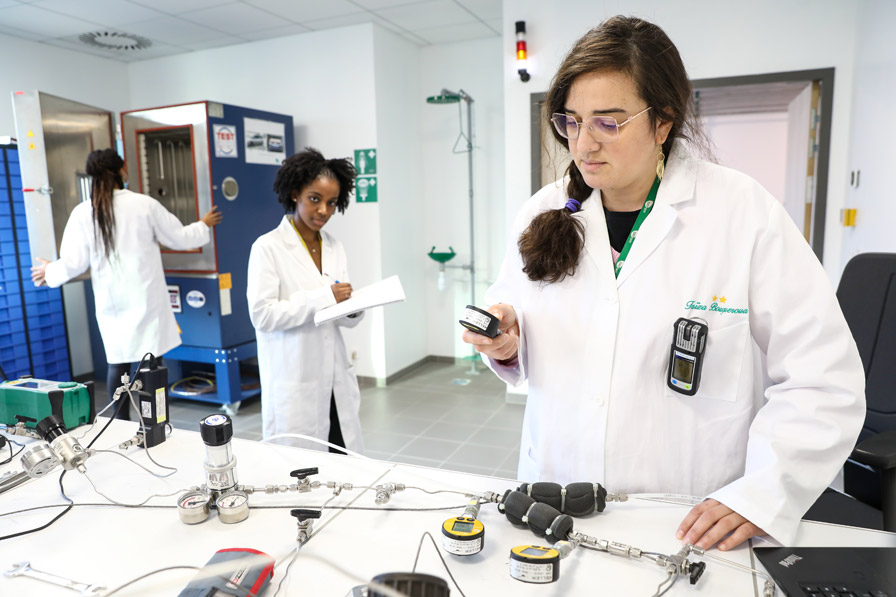The third gas revolution is underway in Alfortville

Developing a hydrogen sector was something that featured strongly at the recent COP26, and is a major challenge for the energy transition. GRTgaz is working on this issue, and since 2018 has been able to call on its Research and Innovation Center for Energy (RICE) dedicated to renewable gas.
“Enabling the existing gas networks to be used to transport hydrogen is the most environment-friendly, flexible and competitive solution,”Tanguy Manchec
RICE Hydrogen Director
Operating at the vanguard of European hydrogen research, RICE has set itself the goal of defining the optimal conditions for converting the gas industry to renewable gas. The inauguration of the FenHYx (Future Energy Network for HYdrogen and miX) test platform is a key stage in this process. Its research will measure the impact of hydrogen on the gas networks’ steelwork and equipment, under conditions close to actual operating conditions. “Enabling the existing gas networks to be used to transport hydrogen is the most environment-friendly, flexible and competitive solution,” explains Tanguy Manchec, RICE Hydrogen Director. Of course, this is assuming that the same high levels of safety as the current gas network can be guaranteed - which this is the purpose of the FenHYx platform.
“Workshops were held with the various departments and experts from the Research Centre to sdetermine the needs of the test programme. We also called on the expertise of teams who had worked on existing hydrogen projects, such as Jupiter 1000. And we held a lot of discussions with the other European gas transporters.”David Toschini
Programme Director for the GRTgaz Projects and Engineering Department
FenHYx: a collaborative project
Building this platform - among the first of its kind in Europe – required three years of works and studies by the GRTgaz Projects and Engineering department, with a strong collaborative focus. “Workshops were held with the various departments and experts from the Research Centre to sdetermine the needs of the test programme. We also called on the expertise of teams who had worked on existing hydrogen projects, such as Jupiter 1000. And we held a lot of discussions with the other European gas transporters,” recalls David Toschini, Programme Director for the GRTgaz Projects and Engineering Department in charge of managing the FenHYx construction.
“We are facing the same challenges, we have the same types of facilities, and we are exploring the same progress pathways as GRTgaz, even if don’t have quite the same research capacities. It was clear very quickly from RICE’s testing systems that we should move forward with our programme.”Thierry Bottequin
Engineering Department Director for the Belgian transporter, Fluxys
A shared international goal
Converting the gas networks to transport hydrogen is a goal shared by many European operators. “We are facing the same challenges, we have the same types of facilities, and we are exploring the same progress pathways as GRTgaz, even if don’t have quite the same research capacities. It was clear very quickly from RICE’s testing systems that we should move forward with our programme,” says Thierry Bottequin, Engineering Department Director for the Belgian transporter, Fluxys. Formerly a simple client, Fluxys quickly took on the status of partner. The transporter went on to co-finance tests on steelworks' characteristics in a hydrogen atmosphere. Several other gas companies also joined the consortium (e.g. the UK’s National Grid). With the partnerships in place, all that remained was to manage the project under some extremely complex conditions.
A project disrupted by unprecedented conditions
“The project included some very specific constraints. We had to adapt. We opted for an agile method to be able to change the needs in light of our discussions with the experts,” says David Toschini.
Adaptability proved to be the project’s watchword. On top of the Covid-19 outbreak, project managers had to deal with supply problems for certain materials, the blockage of the Suez Canal, and even a severe storm in Alfortville.
“This project could not have been completed without the full involvement of the multi-directional project team lead by Jean Imbach and the experts from RICE. We faced up to the adversity together. It was a fantastic adventure that is ending - or should I say is just beginning, as other projects will inevitably follow on,” cconcludes the GRTgaz Programme Director. Tanguy Manchec and the teams from RICE want to gradually integrate new test systems to step up this research into injecting hydrogen into the networks, enabling the transformation of gas infrastructures both in Europe and worldwide.

Thierry Trouvé, Directeur Général de GRTgaz, Marie-Eve Perru, conseillère régionale de la Région Ile-de-France et Pierre Blouet, directeur du centre de R&D RICE (Research and Innovation Center for Energy): fenHYx inauguration on 23 November 2021 (Alfortville).

